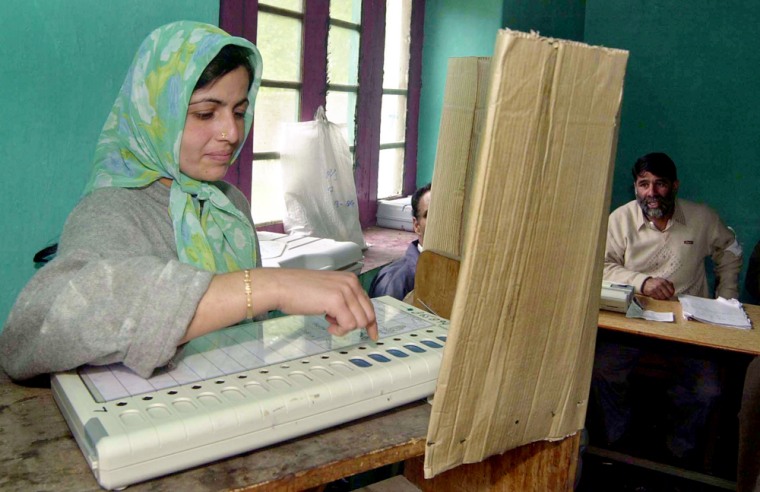For decades, millions of illiterate Indians voted by pressing their thumbprints on ballot cards. This year, they'll just press a button. And so will everyone else.
India’s parliamentary elections, which began Tuesday, are set to make the world’s largest democracy also the world’s largest user of computerized voting machines.
This year, in a staggered vote that runs through May 10, India’s 660 million registered voters are casting their ballots using about 1 million computerized machines.
Other countries, including Brazil, the United States, and the Netherlands, also use electronic voting machines, but in smaller numbers. And India’s are potentially more secure from tampering because they retain a significant low-tech component.
Nonetheless, the election still faces traditional problems. Rebels from the disputed province of Kashmir to India’s isolated northeast have promised to sabotage the vote. Attacks are relatively routine during Indian elections, and violence across the country killed 15 people and wounded 18 on Tuesday.
Machines have been brought to polling centers in deserts, remote hills and even Himalayan valleys where election officials travel on horse, elephant, camel or yak.
Hopes of fighting fraud
The small, portable voting machines, manufactured by two state-run companies and used in smaller numbers in past years, are being deployed to tackle one of the biggest problems in Indian elections: vote fraud.
In this sprawling nation with hundreds of thousands of villages, elections in remote areas have often become free-for-alls, with local political thugs indulging in what is known as “booth capturing.”
Paid by politicians, armed attackers would swoop down on polling stations, firing weapons to seize control. Then, watched by the helpless polling officials, the armed men would stamp ballots in favor of their chosen candidate and stuff them in ballot boxes.
Sometimes, when candidates knew they had done badly in a certain constituency, they hired men to simply steal the ballot boxes as they were being transported to counting centers.
The new machines, the Election Commission says, are a way to fight such practices. At the first sign of trouble, polling officials can shut down the machines at the press of a button, making them useless if stolen. Officials say another machine would then be used to continue voting.
Safety precautions
The devices will also be less prone to hacking, a concern that security experts have raised with the larger machines in the United States. The Indian devices use microprocessors with software burned in, so it cannot be altered or replaced.
They also are not connected to the Internet. Votes are counted not by sending data over telephone lines, where there is potential for manipulation, but by physically bringing the machines to one of thousands of counting centers. There, with representatives from each candidate watching, results are read off the machines one by one and tabulated.
The machines consist of a control unit operated by polling officials, and a balloting unit where people vote. By requiring activation on both ends, officials say, a voter cannot vote twice.
The Election Commission invited all political parties to try out the machines and ask questions, and none raised any security objections.
“It is safe, secure, tamper proof and error-free,” said Ajay Narain Jha, Deputy Election Commissioner. “This has been repeatedly proved over the past four years since we have started using it.”
Vinnie Mehta, executive director of the Manufacturers’ Association of Information Technology, agreed.
“I can’t think of another machine from any country that can handle 600 million votes in such an effective and safe way,” Mehta said.
If nothing else, they’re a novelty for voters.
“I am going to polling booth just to see the electronic voting machine,” said Mahendra Majhi, an illiterate farmer in the Biramitrapur village of the eastern Orissa state.
“I am excited that I am not lagging behind but also operating a modern machine,” said Babul Deka, a farmer in the northeastern state of Assam.
Supporters also say the machines are good for the environment. More than 8,800 tons of paper, made from approximately 16 million trees, has been used to print ballots for past federal elections.
But the machines have not been entirely problem-free.
On Tuesday, machines malfunctioned in some parts of the country, forcing voting to be suspended briefly.
In central Chhattisgarh state, militants attacked election officials, injuring four and making off with machines.
And some officials say voters don’t understand how to use them.
“We are really apprehensive if most of the people can make the right choice,” said Ajoi Kalita, a polling agent in Assam state. “Not enough demonstration has been given to the people as to how the machines are operated.”
